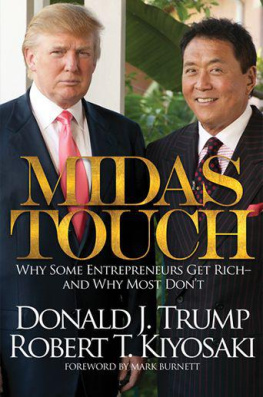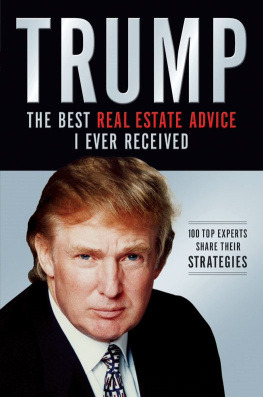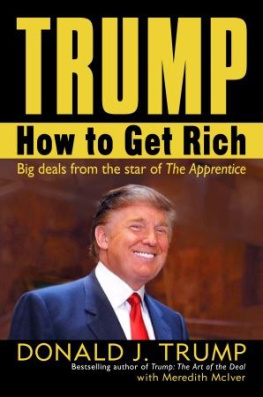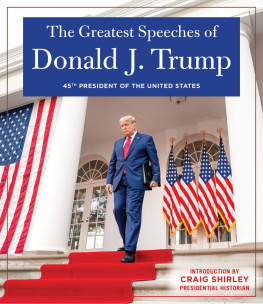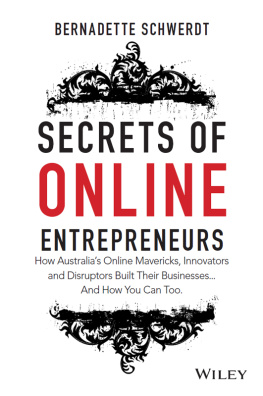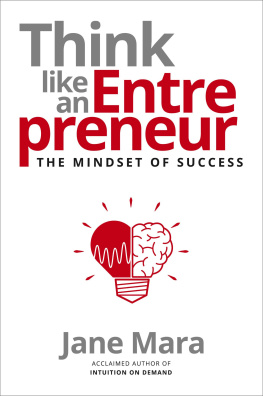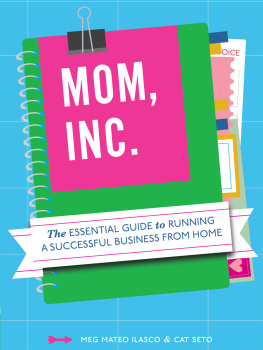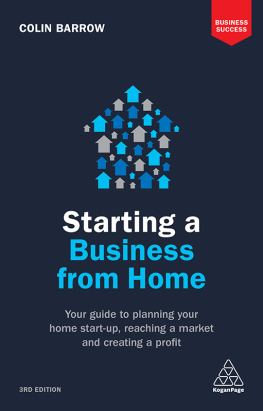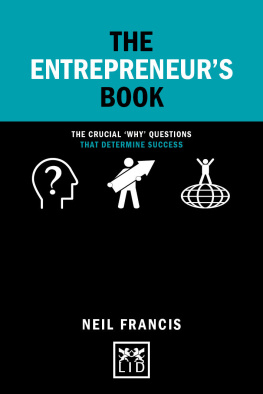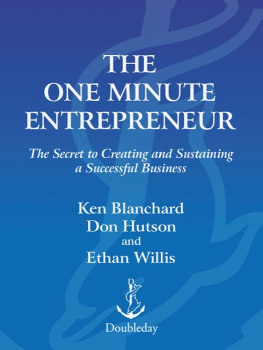We would like to thank all the people who contributed to our lifelong passion of entrepreneurial learning. Without them this book, which is based on our experiences, would not have been possible.
Wed also like to acknowledge our wins and our losses, our successes and our failures because, without lifes balance of ups and downs and the personal and professional growth that comes with it, we would not be where we are today.
A special thank-you goes to Meredith McIver and Kathy Heasley who provided editorial assistance. Special thanks as well to Allen Weisselberg, Michael Cohen, Rhona Graff, Jonathan Gross, and Kacey Kennedy at The Trump Organization and Mike Sullivan, Marian Van Dyke, Anita Rodriguez, Michael Joe, Rhonda Hitchcock, Darrin Moore, and Mona Gambetta at The Rich Dad Company and Plata Publishing. Their collaborative efforts and entrepreneurial insights helped bring our vision of Midas Touch to life.
Finally, wed like to thank all the entrepreneurs who are innovating, risking and overcoming every hurdle to better their lives, their families lives and the lives of billions of people around the world.
There is nothing more noble than entrepreneurship, and we applaud you for your efforts, for your success and for your contributions to our world.
Foreword
by Mark Burnett
Entrepreneurs have a singular drive that gets them where theyre going. Its a focus that is so intense that nothing can derail them or their plans.
Years ago, long before meeting Donald, I read his first book, The Art of the Deal. At the time, I was selling T-shirts on the beach in Los Angeles. In between customers, I was constantly reading The Art of the Deal. I especially appreciated that it was written for someone like mesomeone who had never been to business school. I was in total awe of this real estate mogul, Donald Trump, and never believed I would set eyes on the man himself, let alone meet him. I certainly never imagined that I would be in business with him.
One of wo the most memorable stories I can remember from The Art of the Deal was the story about how Donald can spot a loser. He explained that a loser is the person with a for-sale sign on a dirty car. While this seems obvious, its amazing the number of people who do exactly this in various ways in various businesses.
Robert has sold well over 30 million books in countries all over the world. He obviously has a message that people want or need to hear. He sees himself primarily as a teacher, and I admit that I see Donald as a teacher as well. The Apprentice has an educational subtext that he taps into very well, and I think its one reason the TV show has had the resonance and longevity that it has had. These two teachers, these two titans of business, have a message for all of us.
As Midas Touch points out, entrepreneurship is something that has become somewhat of a responsibility these days, or should be. Thats why this book is timely. We need people who have the talent to create jobs. Those who have the skills or ability to be an entrepreneur need to develop these skills in order to contribute to our society. This book comes from two highly accomplished entrepreneurs with very different backgrounds who cover the bases from different perspectives.
Anyone wanting to enter the leagues of entrepreneurship should give this book a thorough read.
Entrepreneurs are characterized by singular focus and powerful drive. I saw that aspect of Donald a long time ago, and Robert has it as well. I can tell you that their drive is palpable. They dont stop, and the successes they have achieved are remarkable. I hope you will take the time to listen to what they have to say.
Preface
Dreamer or
Entrepreneur?
One entrepreneur, a mechanically minded man since childhood, saw his chance to change the world. He saw a way to better it for people everywhere. So he set out, not to build his fortune, but to build his dream of a new way of life for everyday people.
He struggled with the challenges of honing his idea, prototyping countless versions of his producteach one a slight improvement over the lastand building his company. But his greatest struggle was with people who couldnt see his vision, who couldnt expand their focus and see things as they could be, rather than as they were. The battles were many, but he kept going. He doubted himself, made plenty of sacrifices along the way and got sidetracked many times. He failed often and, because he always loved famous sayings, he called failure the opportunity to begin againmore intelligently.
He wasnt a good student and learned very little in school, but he did love to take things apart to see how they worked. Dismembering watches was a favorite pastime. He had no advanced degree, but he did attend night school to hone his skills. His mind was brilliant, and eventually he became a much-loved teacher of his craft. He attracted students who, like him, were enthusiasts. In the late hours of the night, they would volunteer their time to work on projects and learn in the process. His ability to attract talent and work with others was enviable. In his business, he surrounded himself with people who knew what he did not.
He succeeded at raising money from investors who believed in his producve t. The problem was that they didnt always believe in his vision. He grew despondent because they only focused on money. At one point, he was fired from his own company, the company that bore his name. A lesser man would have called it quits and found a job.
Years earlier, he had given up a steady job with a prominent company. Entrepreneurship didnt pay very well so his family moved countless times into ever more modest surroundings. Ironically, while still working his day job, inspiration came from his iconic employer, a man he had idolized from childhood and had the honor to meet one day, just for a moment. In a few quick strokes, he sketched his innovation. The man before him pounded his fist on the table and said, Young man, thats the thing. You have it. Keep at it.
That bang on the table was worth worlds to me, the entrepreneur told his patient wife. You wont be seeing much of me for the next year. In truth, success took more than a year. It took decades.
Answers rarely come through a eureka moment, and they didnt for Henry Ford. He observed the world around him and slowly arrived at his opportunity and his purpose. He demonstrated that an entrepreneur need not be the inventor of a new technology. His wild success came through something more valuablea brand. Custom-made cars, the standard of the time, didnt align with Henry Fords view of the world. He wanted to give everyone a luxury only the rich could then afford.
He wanted to change the world and believed the secret was an automobile with a gas combustion engine, assembled in a factory, where one car was the same as the next. His hero and famous employer, Thomas Edison, believed that too. Thats why he pounded his fist on the table, reinvigorating Henry and prompting him to keep going through many years and many failures.
Henry dared to dream big. One Sunday he heard his minister preach, Hitch your wagon to a star, and he told his sister, Thats what Im going to do. That was in 1893. Ten years later, on July 23, 1903, Chicago dentist Dr. Ernst Pfenning bought Ford Motor Companys very first Model A.

